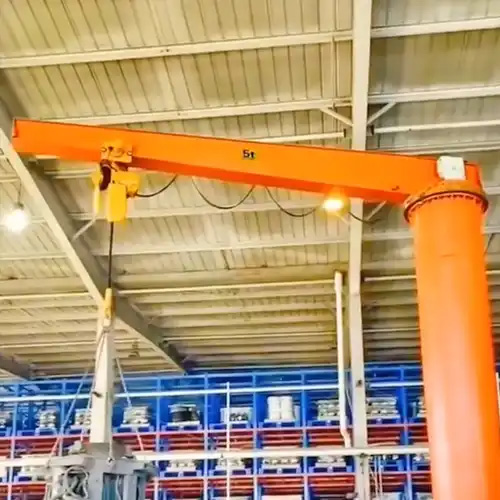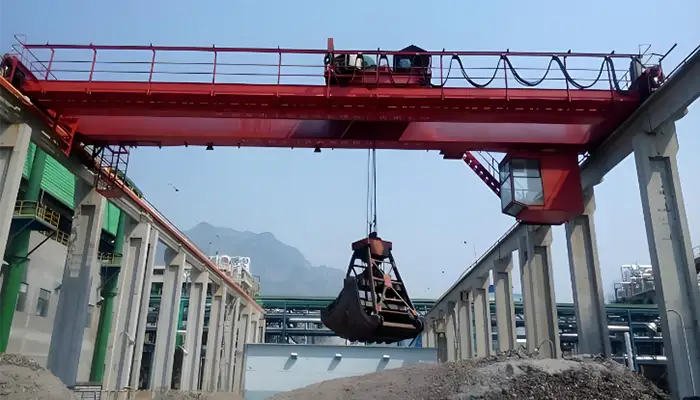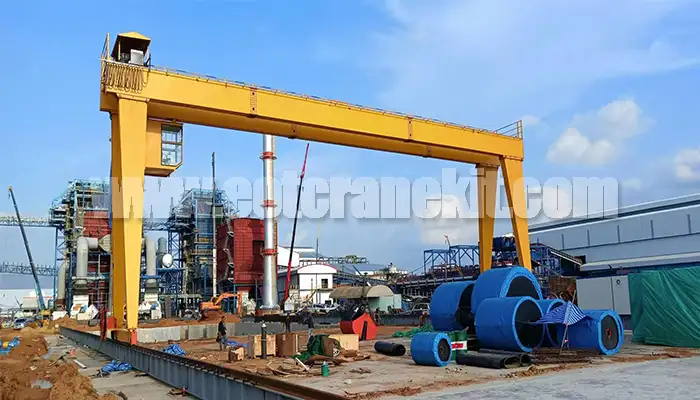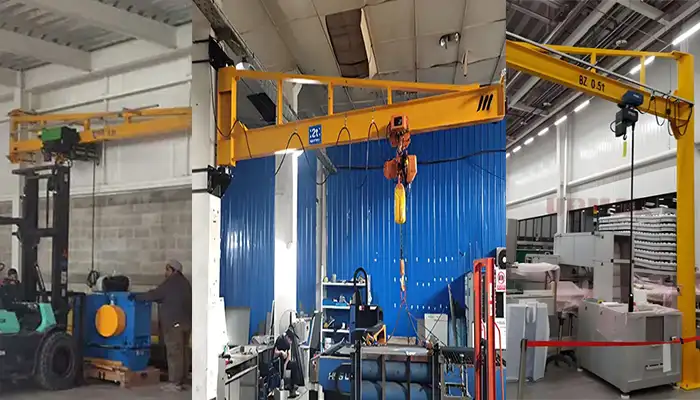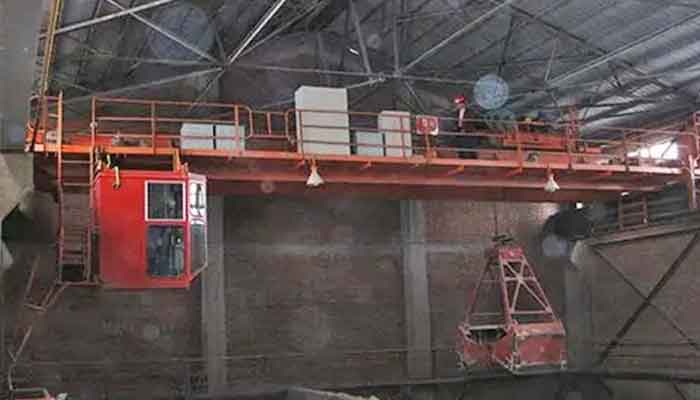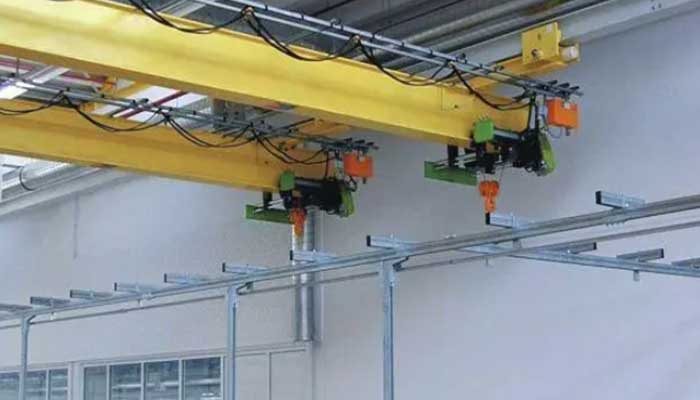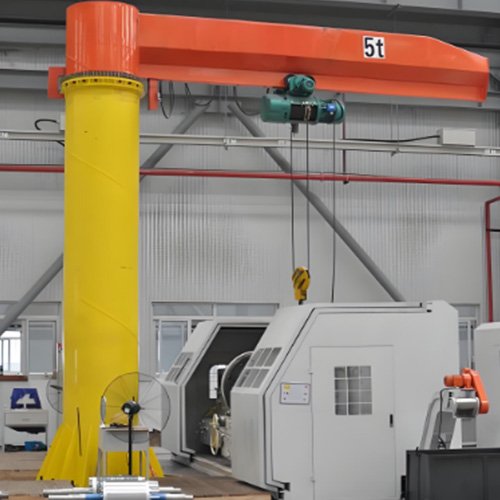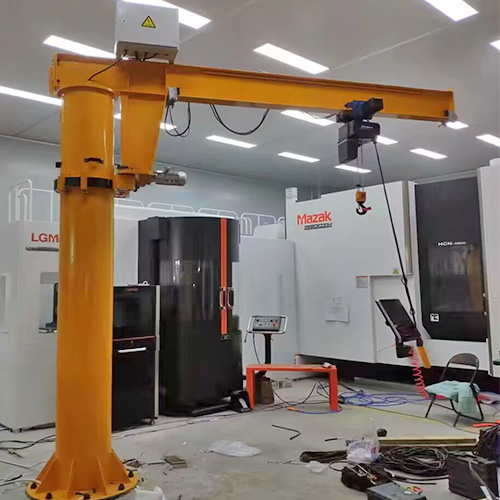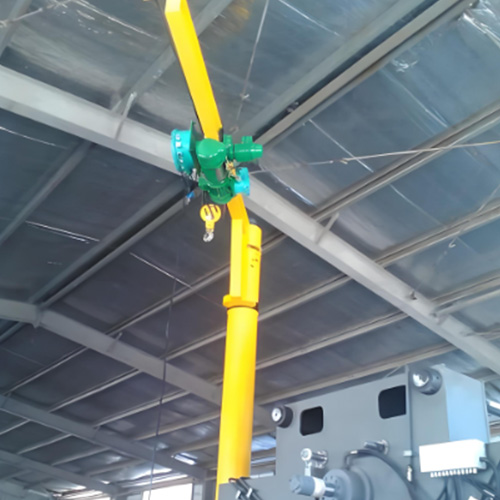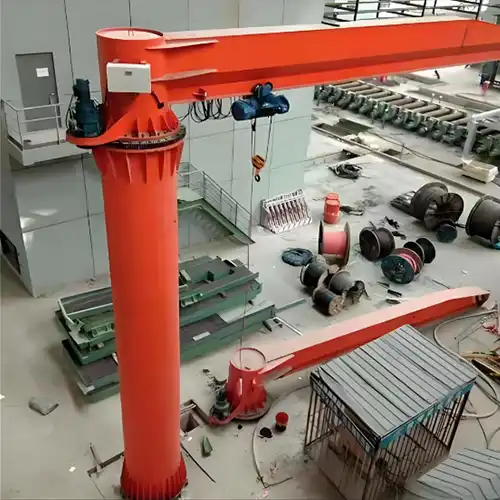5 Ton Jib Cranes: Versatile Heavy-Duty Solutions
5 ton jib cranes for sale. Custom jib crane 5 ton for heavy-duty lifting with robust load capacity, flexible installation options, for various applications.
Category: Jib Crane Capacity & Tonnages
Your Trusted Jib Crane Manufacturer & Supplier
5 Ton Jib Cranes: Versatile Heavy-Duty Solutions
In heavy-duty lifting solutions, few tools are as versatile and indispensable as the 5 ton jib crane. These powerful machines serve as the backbone of countless industrial operations, providing a reliable means of lifting and maneuvering heavy loads with precision and efficiency. In this blog, we'll explore the versatility and importance of 5 ton jib cranes across various industries, shedding light on their essential role in modern manufacturing, construction, shipbuilding, and beyond.
The significance of heavy-duty lifting solutions cannot be overstated in industries where the movement of large, cumbersome loads is a daily requirement. Whether it's lifting steel beams on a construction site, transporting heavy machinery in a manufacturing facility, or maneuvering ship components in a shipyard, the ability to handle heavy loads safely and efficiently is paramount to productivity and success. This is where 5 ton jib cranes truly shine, offering a reliable and versatile solution for a wide range of lifting tasks.
Main Types of 5 Ton Jib Crane Designs for Heavy Duty Material Handling Solutions
5 ton jib cranes represent a critical component in heavy-duty material handling solutions across various industries. These robust and versatile lifting devices are specifically designed to handle loads of up to 5 tons with precision and efficiency. They consist of a horizontal boom or arm that is attached to a vertical mast, allowing for 360-degree rotation and precise positioning of loads within a defined radius. The design of 5 ton jib cranes makes them ideal for applications where heavy loads need to be lifted, moved, and positioned with ease.

Floor-Mounted Pillar Jib Cranes
Floor-mounted jib cranes are heavy-duty lifting devices that are securely anchored to the floor of a facility, providing a stable and fixed point for lifting and maneuvering heavy loads. They consist of a vertical mast mounted on a sturdy base plate, with a horizontal boom or arm extending from the mast. The boom is equipped with a hoist or lifting mechanism that allows for the vertical lifting and horizontal movement of loads within a defined radius. Floor-mounted jib cranes typically offer 360-degree rotation, providing maximum flexibility and coverage within the designated work area. These cranes are available in various configurations, including full cantilever, semi-cantilever, and tie-rod-supported designs, to suit different lifting requirements and space constraints.
Applications in Various Industries:
Floor-mounted jib cranes find wide-ranging applications across various industries, including manufacturing, warehousing, construction, and automotive. In manufacturing facilities, they are commonly used for lifting and moving heavy machinery, equipment, and components during production processes. In warehousing and logistics operations, they facilitate the loading and unloading of heavy materials and palletized goods. In the construction industry, they assist in lifting and positioning construction materials, such as steel beams and precast concrete panels, on job sites. Additionally, floor-mounted jib cranes are utilized in automotive workshops for handling vehicle components and assemblies.
Advantages and Limitations:
The advantages of floor-mounted jib cranes include their robust construction, which provides stability and durability for heavy-duty lifting tasks. They offer 360-degree rotation, allowing for precise positioning of loads and maximum coverage within the work area. Floor-mounted jib cranes are also relatively easy to install and require minimal space compared to overhead cranes, making them suitable for facilities with limited headroom or overhead clearance. However, one limitation of floor-mounted jib cranes is that they are fixed in place and cannot be easily relocated once installed. Additionally, their lifting capacity and reach are limited by the size and configuration of the crane, which may not be sufficient for handling extremely heavy or oversized loads. Despite these limitations, floor-mounted jib cranes remain a cost-effective and efficient solution for many material handling applications.

Wall-Mounted Jib Crane
A wall-mounted jib crane is a type of jib crane that is fixed to a vertical support, such as a wall or a column. It consists of a horizontal boom, which supports a hoist, and is designed to facilitate lifting and moving materials within a work area. The boom can typically rotate up to 200 degrees, providing a wide range of motion for the hoist and load.
Applications
Wall-mounted jib cranes are highly versatile and used in various industrial settings, including:
Manufacturing and Assembly Lines: Ideal for repetitive lifting tasks, such as moving parts from one workstation to another.
Warehouses and Distribution Centers: Useful for loading and unloading materials, and organizing inventory.
Workstations: Enhances efficiency by allowing workers to lift and position heavy tools or components.
Maintenance and Repair Areas: Helps in lifting heavy machinery parts or tools, facilitating repair and maintenance tasks.
Advantages
Space Efficiency: Since they are mounted on walls or columns, these cranes save floor space, making them ideal for small or congested work areas.
Cost-Effective: Typically less costly than freestanding jib cranes due to the elimination of the need for a separate support structure.
Flexibility: The boom's wide arc of movement allows for efficient coverage of the work area, enhancing operational flexibility.
Easy Installation: Relatively straightforward to install on existing structural walls or columns, reducing installation time and costs.
Safety Improvement: Reduces the need for manual lifting, thereby decreasing the risk of worker injuries and increasing overall workplace safety.
Enhanced Productivity: By providing localized lifting solutions, these cranes can significantly improve workflow and productivity.
Limitations
Load Capacity: The crane's load capacity is limited by the strength and structural integrity of the mounting wall or column.
Range of Motion: The area of operation is restricted to the vicinity of the mounting surface, limiting its use for broader workspace coverage.
Installation Constraints: Requires a strong and suitable wall or column for safe installation, which may not always be available in every workspace.
Limited Lifting Height: The maximum lifting height is constrained by the height of the wall or column on which it is mounted.
Potential Structural Modifications: In some cases, additional structural reinforcement of the mounting surface may be necessary, adding to the installation complexity and cost.
Wall-mounted jib cranes are effective solutions for specific lifting and material handling needs, offering a balance of cost efficiency, space saving, and functional utility. However, their limitations must be carefully considered to ensure they meet the requirements of the intended application.
Specialized Designs for 5 Ton Jib Cranes
In industrial settings where safety and environmental factors are paramount, specialized designs for 5 ton jib cranes offer tailored solutions to meet specific requirements. Let's explore two notable examples:
Explosion-Proof Jib Cranes for Hazardous Indoor Use:
Customized Solutions for Specific Applications: Explosion-proof jib cranes are meticulously engineered to operate safely in environments where flammable gases, vapors, or dust are present. These cranes are constructed with special enclosures, seals, and components to prevent the ignition of hazardous substances, minimizing the risk of explosions or fires.
Examples and Use Cases: Explosion-proof jib cranes are commonly used in chemical processing plants, oil refineries, pharmaceutical facilities, and other industrial settings where the presence of combustible materials poses a significant risk. These cranes facilitate the safe handling and movement of materials and equipment in hazardous environments, ensuring compliance with strict safety regulations.
Advantages and Considerations: The primary advantage of explosion-proof jib cranes is their ability to safely operate in hazardous indoor environments, minimizing the risk of catastrophic incidents. However, these specialized cranes often require higher upfront costs due to the additional engineering and safety features required. Additionally, regular maintenance and inspections are essential to ensure continued compliance with safety standards and regulations.
Anticorrosion Jib Crane for Outdoor Use:
Customized Solutions for Specific Applications: Anticorrosion jib cranes are designed to withstand harsh outdoor conditions, including exposure to moisture, saltwater, and corrosive chemicals. These cranes are constructed from corrosion-resistant materials such as stainless steel or galvanized steel, and they are equipped with protective coatings to prevent rust and corrosion.
Examples and Use Cases: Anticorrosion jib cranes find applications in marine terminals, shipyards, coastal facilities, and other outdoor environments where exposure to saltwater, humidity, and corrosive elements is prevalent. These cranes are used for loading and unloading cargo from ships, handling materials in outdoor storage yards, and performing maintenance tasks in coastal areas.
Advantages and Considerations: The primary advantage of anticorrosion jib cranes is their ability to withstand exposure to harsh outdoor conditions, prolonging their lifespan and reducing maintenance requirements. However, these cranes may have higher upfront costs compared to standard indoor cranes due to the use of corrosion-resistant materials and coatings. Additionally, proper installation and regular maintenance are essential to ensure the continued effectiveness and longevity of anticorrosion jib cranes in outdoor environments.
Importance of Selecting the Right Design for Material Handling Needs:
Selecting the right design for material handling needs is crucial to ensure safety, efficiency, and compliance with industry standards and regulations. Whether it's choosing an explosion-proof jib crane for hazardous indoor environments or an anticorrosion jib crane for outdoor use, businesses must carefully evaluate their specific requirements and select a crane design that meets their unique needs. By investing in the right design, businesses can enhance workplace safety, minimize downtime, and optimize material handling operations for maximum productivity and profitability.
Featured 5 ton jib hoists
Jib hoists play a pivotal role in the functionality and effectiveness of 5 ton jib cranes. Let's explore some key features and considerations for these critical components:
- Heavy-Duty Hoisting Capability: Featured 5 ton jib hoists are specifically designed to handle heavy loads of up to 5 tons with precision and efficiency. These hoists are equipped with robust motors, gears, and lifting mechanisms capable of safely lifting and lowering heavy materials and equipment within the designated radius of the jib crane.
- Variable Speed Control: Many featured 5 ton jib hoists come with variable speed control options, allowing operators to adjust the lifting and lowering speeds to match the specific requirements of the lifting task. This flexibility in speed control enhances safety, efficiency, and precision during material handling operations.
- Wire Rope or Chain Options: Depending on the application and preferences of the user, featured 5 ton jib hoists may be available with either wire rope or chain lifting mechanisms. Wire rope hoists offer durability, strength, and smooth operation, while chain hoists are known for their simplicity, reliability, and affordability.
- Safety Features: Safety is paramount in heavy-duty lifting operations, and featured 5 ton jib hoists are equipped with a range of safety features to protect both personnel and equipment. These may include overload protection devices, emergency stop buttons, limit switches, and fail-safe braking systems to prevent accidents and ensure safe lifting operations.
- Remote Control Options: For added convenience and flexibility, some featured 5 ton jib hoists may come with remote control options, allowing operators to control the lifting and lowering operations from a safe distance. This remote control capability enhances operator safety and allows for precise positioning of loads without the need for direct contact with the hoisting equipment.
- Customization and Integration: Featured 5 ton jib hoists can often be customized to meet specific application requirements and integrated seamlessly with the overall design of the jib crane. This customization may include options for specialized hooks, lifting attachments, load monitoring systems, and anti-corrosion coatings to suit the unique needs of the application and operating environment.
In summary, featured 5 ton jib hoists are essential components of heavy-duty material handling solutions, offering robust lifting capabilities, variable speed control, safety features, remote control options, and customization possibilities to enhance productivity, efficiency, and safety in industrial lifting operations.
Industrial Applications
Importance of Heavy-Duty Material Handling Solutions:
In industries such as manufacturing, construction, shipbuilding, and logistics, the efficient handling of heavy materials and equipment is essential for maintaining productivity and ensuring safety. Heavy-duty material handling solutions, such as 5 ton jib cranes, play a vital role in streamlining operations, reducing manual labor, and minimizing the risk of accidents or injuries associated with lifting heavy loads manually. By providing a reliable and efficient means of lifting and maneuvering heavy materials, 5 ton jib cranes contribute to the overall efficiency and profitability of industrial operations. Thus, understanding their importance and capabilities is crucial for businesses seeking to optimize their material handling processes and enhance workplace safety.
When it comes to heavy-duty lifting, 5 ton jib cranes prove their worth across a multitude of industries. Let's explore the diverse range of sectors where these robust machines excel:
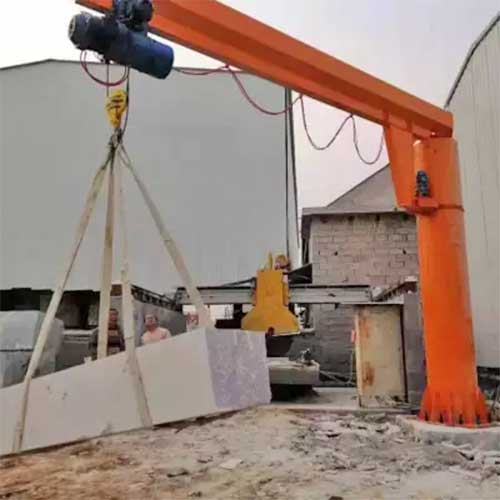
Construction:
In construction, 5 ton jib cranes are indispensable for lifting and positioning heavy materials and equipment. From steel beams and concrete panels to machinery and construction materials, these cranes play a vital role in streamlining operations and enhancing productivity on construction sites of all sizes.
Heavy-Duty 5 ton Jib Crane for Construction Applications
In the construction industry, 5 ton jib cranes serve as indispensable tools for lifting and positioning heavy materials and equipment. Let's delve into the typical features, applications, and loads handled by these cranes on construction sites:
Typical Features:
Robust Construction: Built to withstand the rigors of construction environments, 5 ton jib cranes feature sturdy steel construction and reinforced components for durability and reliability.
360-Degree Rotation: These cranes offer full rotation capabilities, allowing for precise positioning of loads throughout the construction site.
Hoisting Mechanism: Equipped with powerful hoists capable of lifting heavy loads with ease and precision.
Safety Features: Incorporation of safety features such as overload protection, emergency stop buttons, and limit switches ensure safe operation on construction sites.
Typical Applications:
Lifting Steel Beams: 5 ton jib cranes are commonly used to lift and position steel beams during structural construction projects.
Handling Concrete Panels: These cranes facilitate the movement of precast concrete panels for building walls, floors, and other structural elements.
Transporting Machinery: From construction equipment to heavy machinery, jib cranes are instrumental in transporting equipment across construction sites.
Placing Construction Materials: They assist in placing materials such as bricks, blocks, and piping at elevated locations within the construction site.
Supporting Formwork: Jib cranes provide support for formwork systems used in concrete pouring and shaping operations.
Typical Loads Handling:
Steel Beams: Large steel beams used for structural support and framing.
Concrete Panels: Precast concrete panels for building walls and floors.
Machinery and Equipment: Heavy construction machinery, including excavators, loaders, and cranes.
Construction Materials: Bricks, blocks, piping, and other building materials required for construction projects.
Formwork Components: Supporting formwork panels, beams, and props during concrete pouring and curing processes.
In summary, 5 ton jib cranes are indispensable assets on construction sites, offering robust construction, versatile applications, and efficient handling of heavy loads. With their ability to lift and position a wide range of materials and equipment, these cranes contribute to the productivity, safety, and success of construction projects of all scales.
Special Features of Jib Cranes for Construction Site
For jib cranes used in construction, the typical features related to lifting height are indeed crucial, especially when considering their installation atop buildings or structures to handle raw materials and equipment. Here are some typical features of jib cranes used in construction:
- Extended Lifting Height: Jib cranes designed for construction sites often feature extended lifting heights to reach elevated locations on buildings or structures. These cranes may have booms that extend vertically several meters above the column height to facilitate lifting and positioning materials at higher levels.
- Telescopic Boom: Some jib cranes come equipped with telescopic booms that can be extended or retracted to adjust the lifting height as needed. This feature provides flexibility in handling materials at different elevations within the construction site.
- Variable Reach: In addition to extended lifting height, jib cranes used in construction may have variable reach capabilities, allowing them to reach out horizontally to access materials positioned at various distances from the crane's mounting point. This flexibility is essential for efficiently covering a wide area within the construction site.
- Heavy-Duty Construction: Construction jib cranes are typically designed with heavy-duty construction and components to withstand the rigors of outdoor use and exposure to harsh weather conditions. Robust materials and reinforced structures ensure durability and reliability in demanding construction environments.
- 360-Degree Rotation: Many construction jib cranes offer 360-degree rotation, allowing for full coverage and access to materials around the construction site. This rotation capability enables operators to position loads precisely and efficiently, maximizing productivity and workflow.
- Safety Features: Safety is paramount on construction sites, and jib cranes often incorporate various safety features to prevent accidents and ensure safe operation. These may include overload protection, emergency stop buttons, limit switches, and anti-collision systems to safeguard personnel and equipment.
- Remote Control Options: Some construction jib cranes may be equipped with remote control options, allowing operators to control the crane's movements from a safe distance. Remote control capabilities enhance safety and efficiency, particularly when maneuvering loads in challenging or hazardous environments.
Overall, jib cranes used in construction are tailored to meet the unique requirements of building sites, with features such as extended lifting height, telescopic booms, variable reach, heavy-duty construction, 360-degree rotation, safety features, and remote control options. These features ensure that construction jib cranes can effectively handle the lifting and positioning of materials at elevated heights and across various areas of the construction site, contributing to the efficiency and success of construction projects.

Manufacturing:
Within the manufacturing sector, 5 ton jib cranes play a pivotal role in handling heavy machinery, equipment, and components with precision and efficiency. Let's delve into the typical features, objects handled, and applications of 5 ton jib cranes used in manufacturing:
Typical Features:
- High Load Capacity: 5 ton jib cranes are engineered to lift and transport heavy loads weighing up to 5 tons with ease and precision, making them ideal for the robust demands of manufacturing operations.
- Precision Controls: These cranes are equipped with precision controls that allow operators to maneuver loads with accuracy, ensuring smooth and efficient handling throughout the manufacturing process.
- Flexible Mounting Options: Depending on the layout and requirements of the manufacturing facility, 5 ton jib cranes can be installed using various mounting options, including floor-mounted, wall-mounted, or ceiling-mounted configurations, providing versatility in deployment.
- 360-Degree Rotation: Many 5 ton jib cranes offer full 360-degree rotation, enabling operators to access materials and equipment from all angles within the manufacturing space, maximizing productivity and workflow efficiency.
- Heavy-Duty Construction: Built with robust materials and reinforced components, these cranes are designed to withstand the rigors of continuous use in manufacturing environments, ensuring long-term reliability and durability.
Typical Objects Handled:
- Heavy Machinery: 5 ton jib cranes are commonly used to transport heavy machinery and equipment between workstations, facilitating efficient workflow and assembly processes.
- Oversized Components: These cranes are adept at lifting and maneuvering oversized components onto assembly lines or production machinery, allowing for seamless integration and assembly of complex products.
- Raw Materials: From metal sheets and rods to plastic molds and composite materials, jib cranes are instrumental in transporting raw materials to production areas, ensuring a steady supply for manufacturing processes.
- Finished Products: After production, 5 ton jib cranes can be utilized to move finished products from assembly lines to storage areas or shipping docks, streamlining the logistics and distribution process.
Typical Applications:
- Assembly Line Operations: Jib cranes are often installed along assembly lines to assist in the handling and positioning of components and sub-assemblies, facilitating smooth and efficient production processes.
- Material Handling: Whether loading materials onto machines or transferring finished products to storage areas, jib cranes play a vital role in material handling operations within manufacturing facilities.
- Maintenance and Repair: In addition to production tasks, 5 ton jib cranes are utilized for maintenance and repair activities, providing support for servicing machinery and equipment to minimize downtime and ensure operational uptime.
- Tool and Die Handling: These cranes are used to transport heavy tooling and dies between storage areas and production machinery, ensuring that essential equipment is readily available for manufacturing operations.
In summary, 5 ton jib cranes used in manufacturing boast features such as high load capacity, precision controls, flexible mounting options, 360-degree rotation, and heavy-duty construction. They are adept at handling a wide range of objects, including heavy machinery, oversized components, raw materials, and finished products, and find applications in assembly line operations, material handling, maintenance and repair, and tool and die handling, contributing to the efficiency and productivity of manufacturing processes.
Typical or Special Lifting Devices
In the manufacturing industry, jib cranes are equipped with specialized lifting devices tailored to handle a wide range of materials and components used in the production process. Here are some typical and special lifting devices commonly used with jib cranes in the manufacturing industry:
- Lifting Hooks: Heavy-duty hooks are one of the most common lifting attachments used with jib cranes in manufacturing facilities. These hooks provide a secure connection to various materials and components, allowing for efficient lifting and maneuvering during production processes.
- Lifting Magnets: Lifting magnets are specialized attachments designed to handle ferrous materials such as steel plates, bars, and sheets. These magnets create a powerful magnetic field to securely grip the material, enabling easy and efficient lifting without the need for hooks or slings.
- Vacuum Lifters: Vacuum lifters are used for handling flat or smooth-surfaced materials such as glass, plastic, or metal sheets in manufacturing plants. These lifters create a vacuum seal on the surface of the material, providing a secure grip for lifting and moving without leaving marks or damage.
- Clamps and Grabs: Clamps and grabs are specialized lifting devices used to securely grip and lift materials such as pipes, tubes, and cylindrical objects. These devices come in various configurations, including vertical and horizontal clamps, to accommodate different shapes and sizes of materials.
- Pallet Lifters: Pallet lifters are attachments specifically designed for lifting and moving pallets and containers in manufacturing and warehousing environments. These lifters feature adjustable forks or arms to accommodate different pallet sizes and configurations.
- Sheet Lifters: Sheet lifters are used for handling large and heavy sheets of metal, plastic, or other materials commonly used in manufacturing processes. These lifters feature multiple arms or suction cups to distribute the weight evenly and prevent damage to the material.
- Specialized Tooling: In some manufacturing applications, jib cranes are equipped with specialized tooling or fixtures designed for specific tasks such as welding, machining, or assembly. These tooling attachments allow for precise positioning and manipulation of parts during production processes.
By utilizing these specialized lifting devices, jib cranes in the manufacturing industry can efficiently handle a wide range of materials and components, contributing to increased productivity, safety, and efficiency in production processes.

Shipbuilding:
Shipbuilding is a demanding industry that requires robust lifting solutions to handle large and heavy ship components and assemblies. 5 ton jib cranes are instrumental in facilitating various tasks within shipyards, thanks to their versatility, precision, and ability to withstand the rigorous demands of the shipbuilding process. Let's explore the typical designs, objects handled, and applications of 5 ton jib cranes used in shipbuilding:
Typical Designs:
- Heavy-Duty Construction: Designed with heavy-duty materials and reinforced components, 5 ton jib cranes used in shipbuilding are built to withstand the harsh marine environment and the weight of large ship components.
- Extended Reach: Many shipbuilding jib cranes feature extended reach capabilities to access different areas of the ship under construction, allowing for precise positioning of components during assembly.
- 360-Degree Rotation: Rotational capabilities enable these cranes to cover a wide area within the shipyard, providing flexibility in lifting and positioning tasks.
- Telescopic Boom: Some shipbuilding jib cranes may be equipped with telescopic booms to adjust the lifting height and reach as needed, accommodating varying ship sizes and configurations.
- Outdoor Durability: Given the outdoor nature of shipyard operations, these cranes are often designed with corrosion-resistant materials and protective coatings to withstand exposure to saltwater, humidity, and harsh weather conditions.
Typical Objects Handled:
- Hull Sections: Jib cranes are used to lift and position hull sections, including keel plates, bulkheads, and side panels, during the construction of ships.
- Propulsion Systems: Components such as engines, propellers, and propulsion systems are lifted and installed using jib cranes, ensuring efficient propulsion and maneuverability of the vessel.
- Machinery and Equipment: Shipbuilding jib cranes handle various machinery and equipment, including winches, cranes, pumps, and electrical systems, required for the operation and functionality of the ship.
- Deck Structures: Jib cranes assist in the installation of deck structures, including decks, superstructures, masts, and navigation equipment, to complete the construction of the ship.
Typical Applications:
- Assembly and Construction: Jib cranes play a crucial role in the assembly and construction of ships, lifting and positioning components and assemblies with precision and efficiency.
- Maintenance and Repair: These cranes are utilized for maintenance and repair tasks, providing support for servicing and replacing ship components and equipment as needed.
- Material Handling: Shipbuilding jib cranes transport materials, equipment, and components throughout the shipyard, ensuring a smooth flow of materials and efficient workflow.
- Dockside Operations: Jib cranes are used for loading and unloading materials and equipment onto ships at the dock, facilitating logistics and transportation operations within the shipyard.
In summary, 5 ton jib cranes used in shipbuilding feature heavy-duty construction, extended reach, rotational capabilities, and corrosion-resistant materials to withstand the challenges of the marine environment. They handle a wide range of objects, including hull sections, propulsion systems, machinery, and deck structures, and find applications in assembly, maintenance, material handling, and dockside operations within shipyards, contributing to the efficiency and success of shipbuilding projects.
Typical Lifting Devices of Jib Crane for Objects Handling in Shipbuilding Industry
In the shipbuilding industry, jib cranes are equipped with specialized lifting devices tailored to handle the unique and often massive components involved in ship construction. Here are some typical and special lifting devices commonly used with jib cranes in shipbuilding for handling typical objects:
- Shipbuilding Hooks: These heavy-duty hooks are designed specifically for lifting and maneuvering large ship components such as hull sections, propulsion systems, and deck structures. They provide a secure connection to the load and are capable of supporting substantial weight.
- Spreader Bars: Spreader bars are utilized to distribute the weight of oversized or irregularly shaped ship components during lifting operations. They feature multiple attachment points for lifting slings or cables, ensuring even weight distribution and stability while lifting.
- Lifting Magnets: Lifting magnets are specialized attachments used for handling ferrous materials like steel plates, beams, and machinery components in shipyards. These magnets create a powerful magnetic field to securely grip the material, facilitating efficient and safe lifting without the need for slings or hooks.
- Vacuum Lifters: Vacuum lifters are employed for lifting large, flat materials such as steel plates and panels commonly used in ship construction. These lifters create a vacuum seal on the surface of the material, providing a secure grip for precise positioning during assembly and welding processes.
- Shackles and Chains: Shackles and chains are fundamental lifting accessories utilized to connect lifting slings or cables to ship components and assemblies. They ensure a reliable connection between the lifting device and the load, enhancing safety and stability during lifting operations.
- Wire Rope Hoists: Wire rope hoists are frequently paired with jib cranes in shipyards for vertically lifting and lowering heavy loads with precision and control. These hoists feature a drum or spool around which wire rope is wound, offering reliable vertical lifting motion for various ship components and assemblies.
- Turnover Devices: Turnover devices are specialized attachments employed for rotating large ship components such as hull sections or prefabricated modules during assembly. These devices enable controlled rotation of the load, facilitating efficient positioning and welding operations during ship construction.
By utilizing these specialized lifting devices, jib cranes in the shipbuilding industry can efficiently handle the diverse array of components and materials involved in constructing vessels, ensuring smooth and safe operations throughout the shipbuilding process.

Steel Fabrication:
In steel fabrication, where precision and strength are paramount, 5 ton jib cranes serve as indispensable tools for handling heavy steel materials and structural components. These cranes play a crucial role in various tasks within steel fabrication facilities, thanks to their robust construction, precision controls, and ability to maneuver heavy loads with ease. Let's explore the typical designs, objects handled, and applications of 5 ton jib cranes used in steel fabrication:
Typical Designs:
- Heavy-Duty Construction: Designed to withstand the weight of heavy steel materials, 5 ton jib cranes used in steel fabrication feature heavy-duty construction and reinforced components for durability and reliability.
- Variable Reach: Many steel fabrication jib cranes come equipped with adjustable boom lengths to accommodate different reach requirements, allowing for precise positioning of steel beams, columns, and components during fabrication processes.
- 360-Degree Rotation: Rotational capabilities enable these cranes to cover a wide area within the steel fabrication facility, providing flexibility in handling materials and accessing workstations.
- Precision Controls: These cranes are equipped with precision controls that allow operators to maneuver heavy steel materials with accuracy, ensuring smooth and efficient workflow throughout the fabrication process.
- Outdoor Durability: Some steel fabrication jib cranes may be installed outdoors or in open-air facilities, requiring corrosion-resistant materials and protective coatings to withstand exposure to the elements.
Typical Objects Handled:
- Steel Beams: Jib cranes are used to transport and position steel beams of various sizes and shapes, including I-beams, H-beams, and W-beams, required for structural framing and support in construction projects.
- Steel Columns: These cranes handle steel columns used for vertical support and structural reinforcement in buildings, bridges, and infrastructure projects.
- Structural Components: Jib cranes assist in the handling of other structural components such as trusses, girders, braces, and plates, necessary for assembling and fabricating steel structures.
- Raw Materials: From steel plates and sheets to bars and rods, jib cranes transport raw materials to processing equipment such as cutting machines, bending presses, and welding stations for fabrication and shaping.
Typical Applications:
- Material Handling: Steel fabrication jib cranes facilitate the movement of heavy steel materials and components within the fabrication facility, ensuring a steady supply of materials to production areas and workstations.
- Assembly and Fabrication: These cranes are used in the assembly and fabrication of steel structures, assisting in the positioning, alignment, and welding of steel components to create finished products.
- Loading and Unloading: Jib cranes handle the loading and unloading of steel materials onto processing equipment, trucks, and storage racks, streamlining logistics and transportation operations within the facility.
- Maintenance and Repair: In addition to production tasks, these cranes provide support for maintenance and repair activities, facilitating the servicing and replacement of equipment and components as needed.
In summary, 5 ton jib cranes used in steel fabrication feature heavy-duty construction, variable reach, 360-degree rotation, precision controls, and outdoor durability. They handle a wide range of steel objects, including beams, columns, and structural components, and find applications in material handling, assembly, loading and unloading, and maintenance within steel fabrication facilities, contributing to the efficiency and success of steel fabrication processes.
Specialized Lifting Devices for Jib Cranes in Steel Fabrication:
- Lifting Magnets: Lifting magnets are specialized attachments used with jib cranes to lift and transport ferrous materials such as steel plates, sheets, and beams. These magnets offer a powerful and efficient solution for handling heavy steel materials without the need for slings or hooks.
- Vacuum Lifters: Vacuum lifters are another type of specialized attachment used with jib cranes to lift and transport flat or curved steel materials. They create a vacuum seal on the surface of the material, allowing for secure lifting and precise positioning during fabrication processes.
- Plate Clamps: Plate clamps are designed to securely grip and lift steel plates, sheets, and other flat materials. They attach to the jib crane's hook or lifting device and provide a reliable solution for handling heavy steel materials in steel fabrication operations.
- Spreader Bars: Spreader bars are used to distribute the weight of oversized or irregularly shaped steel components, such as beams or trusses, during lifting operations. They attach to the jib crane's hook or lifting device and provide additional stability and control during material handling.
These specialized lifting devices enhance the versatility and capabilities of jib cranes in steel fabrication industries, allowing for efficient and safe handling of heavy steel materials and components throughout the fabrication process.
Across these industries and beyond, 5 ton jib cranes are the backbone of heavy-duty lifting operations, providing reliable and versatile solutions for handling a wide range of materials and equipment. Their robust construction, high load capacity, and flexible maneuverability make them indispensable tools for enhancing productivity, safety, and efficiency in industrial environments.
Benefits and Versatility
5 ton jib cranes offer a host of benefits that make them indispensable in heavy-duty operations across various industries. Let's delve into the advantages and versatility that these powerful machines bring to the table:
- Efficiency in Heavy-Duty Operations: One of the primary benefits of 5 ton jib cranes is their remarkable efficiency in handling heavy loads. With their high load capacity and robust construction, these cranes excel in lifting and maneuvering large and cumbersome materials with ease. This efficiency translates into increased productivity and reduced labor costs, as tasks that would otherwise require manual lifting or multiple workers can be completed swiftly and safely with a 5 ton jib crane.
- Adaptability to Various Materials and Tasks: Another key advantage of 5 ton jib cranes is their adaptability to a wide range of materials and tasks. Whether it's lifting steel beams on a construction site, transporting machinery in a manufacturing facility, or moving ship components in a shipyard, these cranes can handle diverse materials and equipment with precision and reliability. Their flexible boom configurations and customizable features make them suitable for a multitude of lifting applications, allowing businesses to tackle different tasks with a single, versatile piece of equipment.
- Versatility in Different Industrial Environments: 5 ton jib cranes are designed to thrive in diverse industrial environments, from construction sites and manufacturing plants to shipyards and steel fabrication facilities. Their rugged construction and weather-resistant materials enable them to withstand harsh operating conditions, including extreme temperatures, high humidity, and exposure to dust, debris, and corrosive substances. This versatility ensures that 5 ton jib cranes can perform reliably in various settings, providing consistent performance and uptime even in demanding industrial environments.
In summary, the efficiency, adaptability, and versatility of 5 ton jib cranes make them invaluable assets in heavy-duty operations across industries. Their ability to handle diverse materials and tasks with ease, combined with their rugged construction and reliability, ensures optimal performance and productivity in a wide range of industrial environments. Whether it's lifting heavy loads on a construction site or transporting materials in a manufacturing facility, businesses can rely on 5 ton jib cranes to get the job done safely, efficiently, and effectively.
Key Features
When it comes to heavy-duty lifting, the key features of 5 ton jib cranes set them apart as reliable and efficient solutions. Let's explore the essential characteristics that make these cranes indispensable in industrial settings:
<
- Robust Construction: One of the standout features of 5 ton jib cranes is their robust construction. Built to withstand the rigors of heavy lifting operations, these cranes are engineered with durable materials and reinforced components that ensure longevity and reliability. Whether it's lifting heavy machinery or transporting steel beams, the sturdy construction of 5 ton jib cranes provides the strength and stability needed to handle demanding tasks with confidence.
- High Load Capacity: At the heart of their functionality lies the impressive load capacity of 5 tons. With the ability to lift and maneuver heavy loads weighing up to 5 tons, these cranes offer unparalleled lifting power for a wide range of industrial applications. Whether it's lifting steel beams, machinery, or heavy components, the high load capacity of 5 ton jib cranes ensures that even the heaviest materials can be handled safely and efficiently.
- Flexible Mounting Options: Another key feature of 5 ton jib cranes is their flexible mounting options. These cranes can be configured for various mounting setups, including floor-mounted, wall-mounted, or ceiling-mounted installations, depending on the specific requirements of the application. This flexibility allows businesses to optimize space utilization and tailor the crane's positioning to suit the layout of their facility, ensuring optimal performance and efficiency in lifting operations.
In summary, the robust construction, high load capacity, and flexible mounting options of 5 ton jib cranes make them indispensable tools for heavy-duty lifting in industrial environments. Whether it's lifting heavy machinery in a manufacturing facility or transporting materials in a construction site, businesses can rely on these cranes to provide the strength, stability, and versatility needed to tackle even the most challenging lifting tasks with ease.
Availability and Purchase Options
When it comes to acquiring a 5 ton jib crane for your industrial lifting needs, it's essential to explore the various availability and purchase options. Let's take a closer look at how you can find and invest in the right heavy-duty jib crane for your operations:
Begin your search for a 5 ton jib crane by exploring the available options for sale from reputable suppliers and manufacturers. You can start by conducting online research to identify companies that specialize in heavy-duty lifting equipment. Look for suppliers with a proven track record of delivering high-quality products and excellent customer service.
Once you've identified potential suppliers, take the time to review their product offerings and specifications. Pay close attention to factors such as load capacity, boom length, mounting options, and customization capabilities to ensure that the crane meets your specific requirements.
Contact the suppliers directly to inquire about pricing, availability, and lead times for the 5 ton jib cranes you're interested in. Request detailed quotes that outline the cost of the crane, as well as any additional fees for installation, shipping, or customization.
Considerations When Investing in Heavy-Duty Jib Cranes:
When investing in a heavy-duty jib crane, there are several important considerations to keep in mind to ensure that you select the right equipment for your needs:
- Load Capacity: Ensure that the crane's load capacity is sufficient to handle the heaviest loads you'll be lifting in your operations.
- Durability and Reliability: Look for cranes constructed from high-quality materials and built to withstand the rigors of heavy lifting in industrial environments.
- Customization Options: Consider whether you require any specific customizations or additional features to meet your unique lifting requirements.
- Installation and Maintenance: Factor in the installation process and ongoing maintenance requirements to ensure smooth operation and longevity of the crane.
- Budgetary Constraints: Evaluate the total cost of ownership, including upfront purchase costs, installation fees, and ongoing maintenance expenses, to ensure that the investment aligns with your budgetary constraints.
By carefully exploring the availability and purchase options for 5 ton jib cranes and considering these important factors, you can make an informed decision and invest in a heavy-duty lifting solution that meets your specific requirements and delivers long-term value to your operations.
Conclusion
In conclusion, 5 ton jib cranes stand as versatile heavy-duty solutions that play a crucial role in a wide range of industrial applications. Throughout this exploration, we've highlighted their diverse benefits and versatility, making them indispensable assets in the modern industrial landscape.
From their robust construction and high load capacity to their flexibility in mounting options, 5 ton jib cranes offer efficiency, adaptability, and reliability in heavy-duty lifting operations. Whether it's lifting steel beams on a construction site, handling machinery in manufacturing facilities, or maneuvering ship components in shipyards, these cranes excel in meeting the demands of diverse industrial environments.
As businesses continue to seek efficient and effective solutions for their lifting needs, 5 ton jib cranes remain at the forefront, providing the strength, stability, and versatility required to tackle even the most challenging tasks with ease. We encourage industries to explore the capabilities of 5 ton jib cranes and discover how these powerful machines can enhance productivity, safety, and efficiency in their operations.
In the ever-evolving landscape of heavy-duty lifting, 5 ton jib cranes continue to prove their worth as indispensable tools, empowering industries to lift heavy loads with confidence and precision. Embrace the versatility and benefits of 5 ton jib cranes and unlock new possibilities for your industrial applications.
Main Projects
Related Products
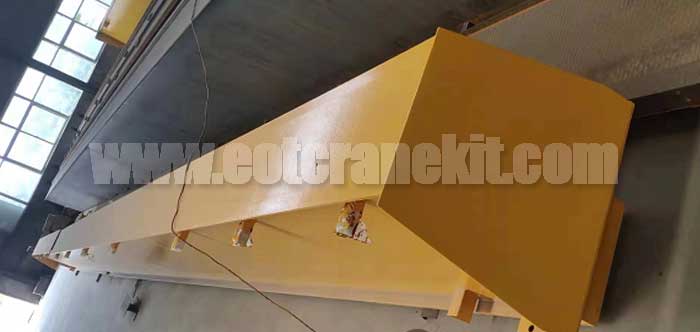
6.3 ton overhead crane kit for sale Philippines, complete single girder top running overhead crane system, low headroom design for workshop indoor use.
Free consultation to Confirm Parameters & Specifications and Get
Latest Crane Price & Crane Rate.
- Types of overhead cranes : _______?
- Optional: Overhead travelling crane, goliath gantry crane,Slewing jib crane, Single girder or double girder crane,small portable crane or kbk crane, etc.
- Capacity of overhead crane: _______?
- Optional: 0.25ton, 0.5 ton, 1 ton, 2 ton, 3ton, 5 ton, 10 ton,15ton, 20ton, 25 ton, 30ton,35ton, up to 550ton, etc.
- Crane span & lifting height : _______?
- Crane travelling length : _____?
- Control of overhead crane:_______?
- Optional: pendant/ remote/cabin control
- Voltage supply of overhead crane:_____?
- Eg,: 380V50/60HZ,3Phase or others,etc.
- Application/usage of crane:_______?
- Eg,: Steel mill, ,injection mold, cement,stone, concrete,granite, general manufacturing, etc.
Just leave a message via the contact form and our hoist and crane engineer will contact you with in 24working hours.
Get In Touch
